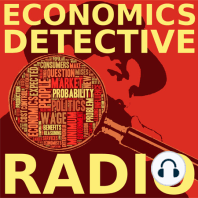65 min listen

Re-thinking the U-Curve of Inequality with Vincent Geloso
Re-thinking the U-Curve of Inequality with Vincent Geloso
ratings:
Length:
50 minutes
Released:
Nov 1, 2016
Format:
Podcast episode
Description
What follows is an edited transcript of my conversation with Vincent Geloso. Petersen: My guest today is Vincent Geloso of the Free Market Institute at Texas Tech University. Vincent, welcome to Economics Detective Radio. Geloso: It's a pleasure to be here. Petersen: So the paper we'll be discussing today is titled "A U-curve of Inequality? Measuring Inequality in the Interwar Period" which Vincent has co-authored with John Moore and Phillips Schlosser. The paper casts doubt on the claim from, most notably, Thomas Piketty and others that inequality fell from the 1920s to the 1960s and rose thereafter. So, Vincent let's start by discussing the inequality literature prior to this paper. What is this U-curve and where did it come from? Geloso: The U-curve is probably the most important stylized fact we have now in the debate over inequality and the idea is that, if you look at the twentieth century, there's a high point of inequality in the 1910s, 1920s and then from the 1930s onwards up to 1970s, it falls dramatically to very low levels and re-increases thereafter, returning to 1920s-like levels of inequality. So the U-curve is the story of inequality in the twentieth century. It's mostly a U.S. story because for other countries it looks less like the U-curve than an inverted J. So it's higher in the 1920s, it still falls like in the U.S. but really increases much more modestly than the United States in places like Sweden, or France, or Canada. But the general story is that there was a high level of inequality at the beginning of the century well up to the mid-second-half of the twentieth century and it re-increased in the latter years and then we have been on a surge since then. Petersen: So, a lot of this is coming from Thomas Piketty, who of course wrote the surprising bestseller "Capital in the Twenty-First Century." Could you talk a little bit about where his data came from? Geloso: Okay, by the way, this is where there's a failing on my part which I think I always find funny; an anecdote to tell about Piketty. I'm originally from Quebec, so I am a French-Canadian, I speak fluent French. His work started coming out in French first and I initially started to write elements of the paper we're discussing today back when it was only in French. And then I told myself, "There's no point, it's only a French book, nobody reads French. What's the point of writing a paper about a book that no one will read?" Biggest mistake of my career, I guess, not writing that paper before. But anyways, besides that, his entire argument is based largely on his most influential paper---which I think was published in 2003 in the Quarterly Journal of Economics---which was using tax data. So, the records, the fiscal statistics to create measurements of income inequality in the United States and the advantage of that is that since the income tax started in 1910s you've got a long, long period of measurement of income inequality with the same source. So it's a great advantage because a lot of the people before like Kuznets, like others had to use residual estimates, different sources, they were amalgamating different sources together and it was always a problem because you couldn't create one homogeneous time-series of inequality. You could get a rough idea and there's a few papers---for those who read economic history stuff---there was a paper by Lindert and Williamson in the 70s in research in economic history and you can see their first graph in that paper was a series of different measures of inequality. They were all pointing to the general similar shaped curve but they were all from massively different statistics, different sources. So one was the 50:10 ratio of earnings, another one was a measure of income, the other was wages and they are all different measures, they are not perfect. You can get a good idea, a rough idea but you cannot have a continuous time estimate which is what Piketty innovated by using the tax-wealth with Emmanuel Saez, r
Released:
Nov 1, 2016
Format:
Podcast episode
Titles in the series (100)
Migration and Open Borders with Nathan Smith: In this episode, Nathan Smith discusses the economics and history of migration and migration restrictions. Nathan is an Assistant Professor of Business Administration: Finance and Economics at Fresno Pacific University and regular blogger at Open... by Economics Detective Radio